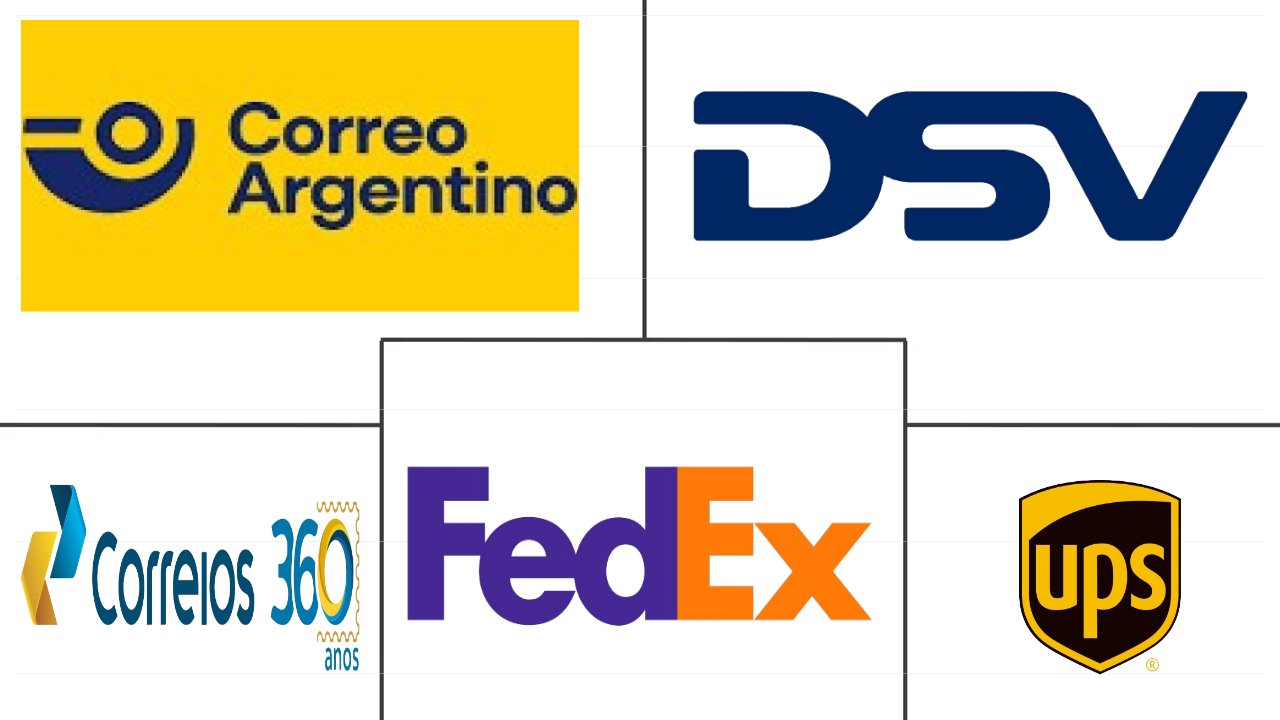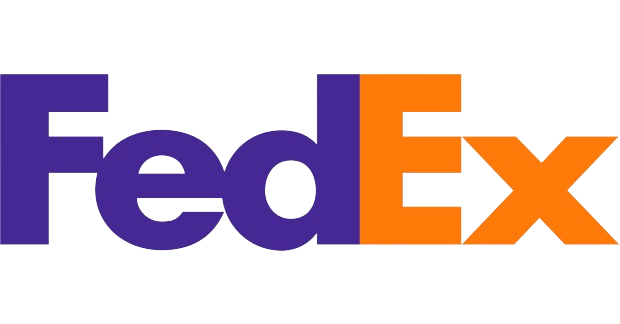Market Size of south america courier, express, and parcel (cep) Industry
| Icons | Lable | Value |
|---|---|---|
|
|
Study Period | 2017 - 2030 |
|
|
Market Size (2024) | USD 7.74 Billion |
|
|
Market Size (2030) | USD 10.92 Billion |
|
|
Largest Share by Destination | Domestic |
|
|
CAGR (2024 - 2030) | 5.92 % |
|
|
Largest Share by Country | Brazil |
|
|
Market Concentration | High |
Major Players |
||

|
||
|
*Disclaimer: Major Players sorted in no particular order |
South America Courier, Express, and Parcel (CEP) Market Analysis
The South America Courier, Express, and Parcel (CEP) Market size is estimated at 7.74 billion USD in 2024, and is expected to reach 10.92 billion USD by 2030, growing at a CAGR of 5.92% during the forecast period (2024-2030).
7.74 Billion
Market Size in 2024 (USD)
10.92 Billion
Market Size in 2030 (USD)
4.38 %
CAGR (2017-2023)
5.92 %
CAGR (2024-2030)
Fastest Growing Market by Speed of Delivery
6.84 %
Projected CAGR, Express, 2024-2030
Leading e-commerce and CEP market players are expanding express delivery services like one-day delivery services, along with various collaborations and network expansions.
Fastest Growing Market by Model
7.70 %
Projected CAGR, Business-to-Consumer (B2C), 2024-2030
E-commerce, a major catalyst facilitating B2C transactions that generate delivery demand, has witnessed rapid growth due to technological infrastructure development.
Largest Market by Shipment Weight
63.41 %
value share, Light Weight Shipments, 2023
The demand for the delivery of goods like fashion items, telephony, and groceries is majorly driving the growth and share of the segment in the region.
Largest Market by End User Industry
38.97 %
value share, Manufacturing, 2023
Collaborations between manufacturing companies and courier and logistics providers have gained traction, with logistics providers managing the entire supply chain.
First leading Market player
37.08 %
market share, FedEx, 2022

FedEx has over 19,000 employees in South America, including Mexico. Also, it offers international courier services from South America to other countries across the world.
The B2C e-commerce segment is leading the market with respect to CEP demand
- B2C e-commerce is one of the industries generating the highest demand in the South American CEP market. Although B2C e-commerce in Latin America had a slow start, it has achieved a penetration rate of over 50% in multiple countries in the region. Brazil ranked the highest in total e-commerce sales across South America in 2021. MercadoLibre, an online marketplace headquartered in Argentina, dominates the South American B2C e-commerce market and accounted for more than two-thirds of the Argentine e-commerce market in 2022, with its retail e-commerce sales reaching over USD 12 billion. With e-commerce projected to reach USD 96.87 billion by 2027, the South American CEP market is expected to grow significantly.
- CEP market in Brazil is growing owing to rising e-commerce. The growth in cross-border trade in Brazil is being driven by the rising number of orders, which recorded a 15% YoY growth in 2022. In alignment, Cainiao, a logistics company of Alibaba expanded in the Brazilian CEP market in 2022. The company launched its first parcel distribution center in Brazil, a major addition to its regional network of sorting centers. The company aims to utilize and expand infrastructure for intra-city and cross-border logistics services and grocery deliveries. The company currently operates 8 weekly chartered flights between China and Brazil and plans to add more air and sea routes between the countries.
- E-commerce growth is expected to majorly boost the CEP market in the region. The e-commerce user penetration is projected to reach 56.5% in 2023 due to rising domestic and cross-border e-commerce in the region. South America is further expected to have 258.10 million e-commerce users by 2027, amounting to a 61.4% user penetration.
Expansion of parcel distribution centres, low-cost air cargo service, among drivers of regional market demand
- The CEP market in the region is driven mainly by a surge in e-commerce-led parcel shipments along with demand from other end users such as manufacturing, BFSI sector among others. Brazil, Chile, Argentina, along with other countries, comprise the CEP market in the region. In Brazil, Magazine Luiza, Casabahia, and Americanas accounted for 36.5% of Brazil's top 100 online stores' revenue, which drove domestic CEP demand in 2022. In Argentina, Mercado Libre has almost 27 million online consumers. By 2025, buyer penetration is expected to touch approximately 62%, significantly impacting domestic CEP demand during the forecast period.
- E-commerce user penetration in Brazil is projected to touch 66.7% by 2027. Cross-border e-commerce demand is thus pushing companies to expand CEP services. For instance, Cainiao, a logistics company of Alibaba, expanded into the CEP market in 2022. In 2022, the company launched its first parcel distribution center in Brazil, a significant addition to its regional sorting center network.
- One of the major demand generators for the courier express and parcel market is B2C e-commerce. Although B2C e-commerce in Latin America had a slow start, it has a penetration rate of over 50% in multiple regional countries. Brazil ranked the highest in e-commerce sales in 2021, followed by Mexico, Colombia, and Argentina. MercadoLibre, an online marketplace headquartered in Argentina, dominated the B2C e-commerce segment in Latin America by being the top seller in several countries, including Argentina, Mexico, and Chile, and accounted for more than two-thirds of Argentina's e-commerce segment in 2022.
South America Courier, Express, and Parcel (CEP) Industry Segmentation
Domestic, International are covered as segments by Destination. Express, Non-Express are covered as segments by Speed Of Delivery. Business-to-Business (B2B), Business-to-Consumer (B2C), Consumer-to-Consumer (C2C) are covered as segments by Model. Heavy Weight Shipments, Light Weight Shipments, Medium Weight Shipments are covered as segments by Shipment Weight. Air, Road, Others are covered as segments by Mode Of Transport. E-Commerce, Financial Services (BFSI), Healthcare, Manufacturing, Primary Industry, Wholesale and Retail Trade (Offline), Others are covered as segments by End User Industry. Argentina, Brazil, Chile are covered as segments by Country.
- B2C e-commerce is one of the industries generating the highest demand in the South American CEP market. Although B2C e-commerce in Latin America had a slow start, it has achieved a penetration rate of over 50% in multiple countries in the region. Brazil ranked the highest in total e-commerce sales across South America in 2021. MercadoLibre, an online marketplace headquartered in Argentina, dominates the South American B2C e-commerce market and accounted for more than two-thirds of the Argentine e-commerce market in 2022, with its retail e-commerce sales reaching over USD 12 billion. With e-commerce projected to reach USD 96.87 billion by 2027, the South American CEP market is expected to grow significantly.
- CEP market in Brazil is growing owing to rising e-commerce. The growth in cross-border trade in Brazil is being driven by the rising number of orders, which recorded a 15% YoY growth in 2022. In alignment, Cainiao, a logistics company of Alibaba expanded in the Brazilian CEP market in 2022. The company launched its first parcel distribution center in Brazil, a major addition to its regional network of sorting centers. The company aims to utilize and expand infrastructure for intra-city and cross-border logistics services and grocery deliveries. The company currently operates 8 weekly chartered flights between China and Brazil and plans to add more air and sea routes between the countries.
- E-commerce growth is expected to majorly boost the CEP market in the region. The e-commerce user penetration is projected to reach 56.5% in 2023 due to rising domestic and cross-border e-commerce in the region. South America is further expected to have 258.10 million e-commerce users by 2027, amounting to a 61.4% user penetration.
| Destination | |
| Domestic | |
| International |
| Speed Of Delivery | |
| Express | |
| Non-Express |
| Model | |
| Business-to-Business (B2B) | |
| Business-to-Consumer (B2C) | |
| Consumer-to-Consumer (C2C) |
| Shipment Weight | |
| Heavy Weight Shipments | |
| Light Weight Shipments | |
| Medium Weight Shipments |
| Mode Of Transport | |
| Air | |
| Road | |
| Others |
| End User Industry | |
| E-Commerce | |
| Financial Services (BFSI) | |
| Healthcare | |
| Manufacturing | |
| Primary Industry | |
| Wholesale and Retail Trade (Offline) | |
| Others |
| Country | |
| Argentina | |
| Brazil | |
| Chile | |
| Rest of South America |
South America Courier, Express, and Parcel (CEP) Market Size Summary
The South America Courier, Express, and Parcel (CEP) market is experiencing significant growth, driven primarily by the surge in B2C e-commerce. Despite a slow initial uptake, e-commerce has now penetrated over half of the market in several South American countries, with Brazil leading in e-commerce sales. The dominance of MercadoLibre in the region's e-commerce landscape underscores the robust demand for CEP services, as the company continues to expand its reach across countries like Argentina, Mexico, and Chile. The growth of e-commerce is further bolstered by increasing cross-border trade, particularly in Brazil, where logistics companies like Cainiao are expanding their operations to enhance intra-city and cross-border logistics services. This expansion is supported by the rising number of e-commerce users and the growing demand for parcel shipments, which are key drivers of the CEP market in the region.
The CEP market in South America is characterized by a consolidation of major players, with companies like Correo Argentino, DSV A/S, Empresa Brasileira de Correios e Telegrafos, FedEx, and UPS holding significant market shares. The region's infrastructure development, including substantial investments in transportation and telecommunications, is expected to further support market growth. Initiatives such as Chile's highway projects and Brazil's logistics expansions are indicative of the ongoing efforts to improve the region's logistics capabilities. Additionally, strategic partnerships and expansions, such as Geopost's entry into Argentina and Cainiao's collaboration with Correios, are aimed at enhancing last-mile logistics and promoting bilateral trade. These developments highlight the dynamic nature of the South American CEP market, poised for continued expansion in the coming years.
South America Courier, Express, and Parcel (CEP) Market Size - Table of Contents
-
1. MARKET SEGMENTATION (includes Market Value in USD, Forecasts up to 2030 and analysis of growth prospects)
-
1.1 Destination
-
1.1.1 Domestic
-
1.1.2 International
-
-
1.2 Speed Of Delivery
-
1.2.1 Express
-
1.2.2 Non-Express
-
-
1.3 Model
-
1.3.1 Business-to-Business (B2B)
-
1.3.2 Business-to-Consumer (B2C)
-
1.3.3 Consumer-to-Consumer (C2C)
-
-
1.4 Shipment Weight
-
1.4.1 Heavy Weight Shipments
-
1.4.2 Light Weight Shipments
-
1.4.3 Medium Weight Shipments
-
-
1.5 Mode Of Transport
-
1.5.1 Air
-
1.5.2 Road
-
1.5.3 Others
-
-
1.6 End User Industry
-
1.6.1 E-Commerce
-
1.6.2 Financial Services (BFSI)
-
1.6.3 Healthcare
-
1.6.4 Manufacturing
-
1.6.5 Primary Industry
-
1.6.6 Wholesale and Retail Trade (Offline)
-
1.6.7 Others
-
-
1.7 Country
-
1.7.1 Argentina
-
1.7.2 Brazil
-
1.7.3 Chile
-
1.7.4 Rest of South America
-
-
South America Courier, Express, and Parcel (CEP) Market Size FAQs
How big is the South America Courier, Express, and Parcel (CEP) Market?
The South America Courier, Express, and Parcel (CEP) Market size is expected to reach USD 7.74 billion in 2024 and grow at a CAGR of 5.92% to reach USD 10.92 billion by 2030.
What is the current South America Courier, Express, and Parcel (CEP) Market size?
In 2024, the South America Courier, Express, and Parcel (CEP) Market size is expected to reach USD 7.74 billion.

